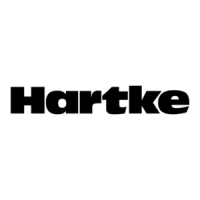14
In both the HA3000 and HA4000, when an EQ knob is in its center detented position (“0”),
it is having no effect. When it is moved right of center, the particular frequency area is
being boosted; when it is moved left of center, the frequency area is being attenuated.
Turning all EQ controls up the same amount will have virtually the same effect as simply
turning up the Volume; conversely, turning them all down the same amount will have
virtually the same effect as turning down the Volume. Both approaches are pointless
(after all, that’s why we gave you a Volume control!)
In many instances, the best way to deal with equalization is to think in terms of which
frequency areas you need to attenuate, as opposed to which ones you need to boost.
Be aware that boosting a frequency area also has the effect of boosting the overall signal;
specifically, too much Low EQ boost (and, in the case of the HA4000, especially too much
“DBASS” band boost) can cause overload distortion or even damage connected speakers.
If you’re using an HA4000, it’s best to attenuate mid-range frequencies with relatively
narrow bandwidths.
In addition, a unique Shape control employs a
notch filter to remove specific frequency areas.
At the same time, it overlays a special equalization
curve that is designed to improve the sound of
electric bass instruments. This curve provides boost at certain frequency areas and
attenuation at other frequency areas. As the Shape knob is turned clockwise, the notch
filter is imposed on higher frequency areas; as it is turned counterclockwise, the filter is
imposed on lower frequency areas. At the fully clockwise position, the filter is applied to
the 1 kHz frequency area, making for a deep, rich tone; at the fully counterclockwise
position, the filter is applied to the 90 Hz frequency area, making for a bright, twangy tone.
The associated Intensity control allows you to set the depth of the Shape curve; the higher
the Intensity, the greater the effect of the notch filter. Note that, when Intensity is set to 0,
the Shape curve has no effect.
The specific EQ (and/or Shape) you will apply to your bass signal is very much dependent
upon your particular instrument and personal taste and playing style. However, here are a
few general suggestions:
• For that super-deep reggae or Motown sound, boost the Low EQ (and, in the HA4000,
the DBASS band) slightly while attenuating the High EQ. Set the Shape control to
approximately 850 Hz, with an Intensity of 5 or 6.
• To remove boxiness and make your instrument sound more “hi-fi,” try attenuating the
Mid Low and Mid High EQ controls (in the HA4000, set the frequencies to 354 Hz and
1.1 kHz, respectively, with both bandwidth controls at about 3 o’clock) and set the
Shape control to approximately 320 Hz, with an Intensity of 6 or 7.
• For a twangy, cutting sound, try boosting the High EQ (putting new roundwound strings
on your bass will help a lot also!) and set the Shape control to approximately 145 Hz,
with an Intensity of 4 or 5.
• Whenever you get a really good EQ (and/or Shape) setting for a particular instrument
or song,
write it down (you’d be amazed how easy it is to forget these things!).
As you experiment with the EQ and Shape controls of your Hartke HA3000 or HA4000,
don’t forget that your bass also provides significant EQ control in the form of its pickup and
tonal settings—this can be particularly effective in instruments that have active circuitry.
Using Equalization and Shape

